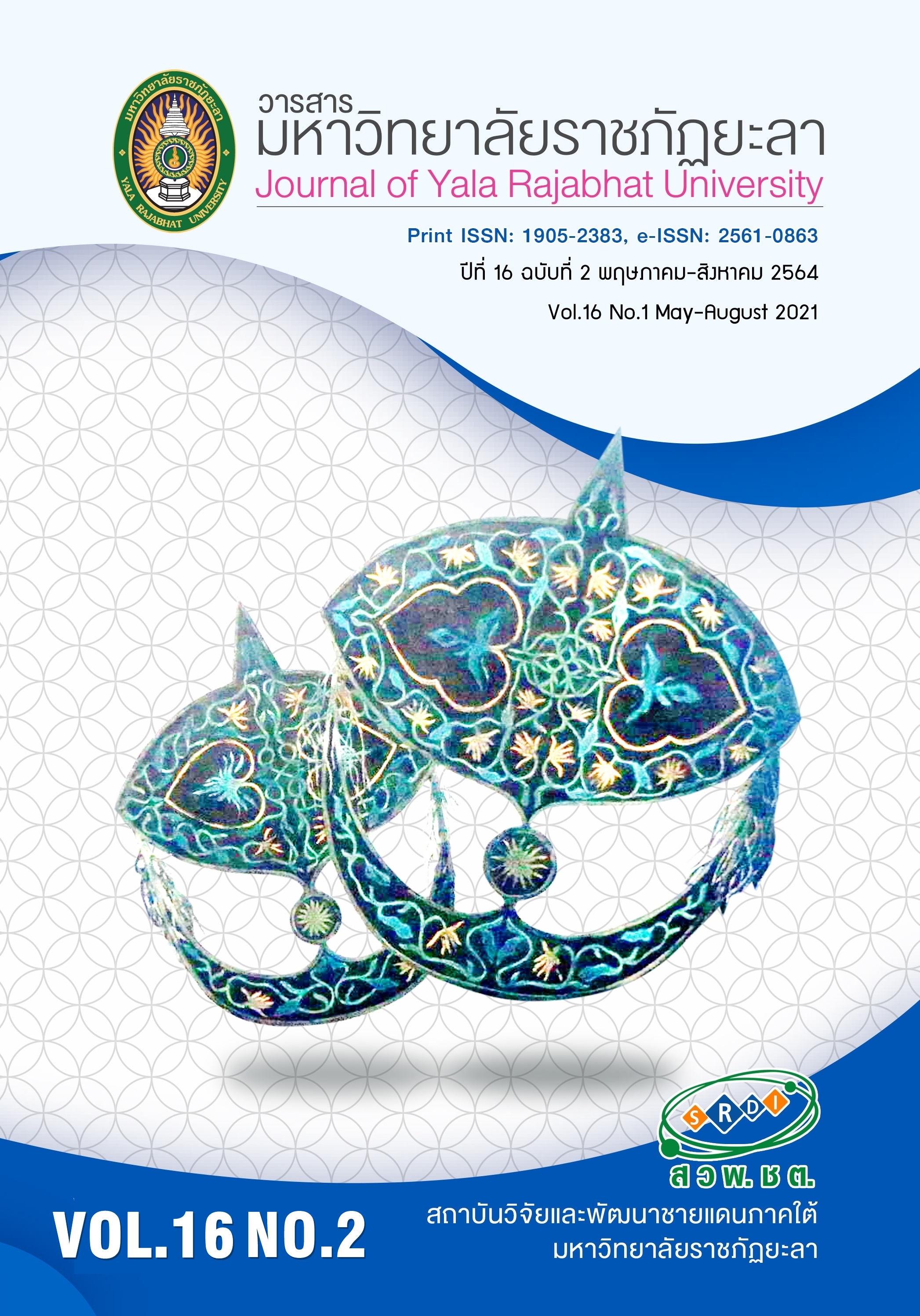การศึกษาคุณลักษณะความสามารถในการใช้เทคโนโลยีสร้างสรรค์อย่างมีวิจารณญาณ สำหรับผู้เรียนชั้นมัธยมศึกษาตอนปลาย
Main Article Content
บทคัดย่อ
ผู้เรียนระดับชั้นมัธยมศึกษาตอนปลายส่วนใหญ่ใช้เทคโนโลยีในลักษณะเป็นผู้รับ และใช้เพื่อความบันเทิงมากกว่าการค้นหาความรู้ นอกจากนี้ยังขาดความสามารถในการนำเทคโนโลยีมาใช้สร้างองค์ความรู้อย่างสร้างสรรค์ รวมทั้งขาดวิจารณญาณในการใช้เทคโนโลยีค้นหาความรู้ จึงทำการวิจัยโดยมีวัตถุประสงค์เพื่อศึกษาคุณลักษณะความสามารถในการใช้เทคโนโลยีสร้างสรรค์อย่างมีวิจารณญาณสำหรับผู้เรียนชั้นมัธยมศึกษาตอนปลาย โดยการวิจัยเอกสาร และการสัมภาษณ์เชิงลึกอาจารย์สาขาเทคโนโลยีการศึกษา และผู้สอนในโรงเรียนระดับมัธยมศึกษาตอนปลาย จำนวน 10 คน ซึ่งเลือกแบบเจาะจง วิเคราะห์ข้อมูลโดยใช้เทคนิคการวิเคราะห์เนื้อหา ตีความสร้างข้อสรุปแบบอุปนัย ผลการศึกษาพบว่า คุณลักษณะความสามารถในการใช้เทคโนโลยีสร้างสรรค์อย่างมีวิจารณญาณสำหรับผู้เรียนชั้นมัธยมศึกษาตอนปลายมี 3 องค์ประกอบ ได้แก่ องค์ประกอบที่ 1 ความสามารถทางด้านการคิด โดยมีพฤติกรรมบ่งชี้ ได้แก่ การใช้เทคโนโลยีสร้างองค์ความรู้ การไตร่ตรองพิจารณาความเหมาะสมการใช้เทคโนโลยี การประยุกต์ความรู้ให้มีความแปลกใหม่ องค์ประกอบที่ 2 ความสามารถทางด้านการปฏิบัติงาน โดยมีพฤติกรรมบ่งชี้ ได้แก่ การปฏิบัติงานอย่างเป็นขั้นตอน เลือกใช้เทคโนโลยีได้อย่างเหมาะสม วิเคราะห์สังเคราะห์กระบวนการปฏิบัติงาน การทำงานและแลกเปลี่ยนเรียนรู้กับผู้อื่น องค์ประกอบที่ 3 ความสามารถทางด้านการพัฒนาบุคลิกภาพ โดยมีพฤติกรรมบ่งชี้ ได้แก่ ช่างสังเกตช่างสงสัย มีความพยายาม ยอมรับฟังความคิดเห็นของผู้อื่น การให้เกียรติผู้อื่นปฏิบัติตนให้เหมาะสมกับสถานการณ์ มีจรรยาบรรณในการใช้เทคโนโลยี อันจะเป็นข้อมูลสำคัญในการนำมาใช้เป็นแนวทางในการจัดการเรียนรู้เพื่อเสริมสร้างความสามารถในการใช้เทคโนโลยีสร้างสรรค์อย่างมีวิจารณญาณ และสามารถนำมาใช้ในการพัฒนาเครื่องมือในการประเมินความสามารถในการใช้เทคโนโลยีสร้างสรรค์อย่างมีวิจารณญาณสำหรับผู้เรียนชั้นมัธยมศึกษาตอนปลายต่อไป
Article Details
บทความ ข้อมูล เนื้อหา รูปภาพ ฯลฯ ที่ได้รับการเผยแพร่ในวารสารมหาวิทยาลัยราชภัฏยะลานี้ ถือเป็นลิขสิทธิ์ของวารสารมหาวิทยาลัยราชภัฏยะลา หากบุคคลหรือหน่วยงานใดต้องการนำทั้งหมดหรือส่วนหนึ่งส่วนใดไปเผยแพร่ต่อหรือกระทำการใดๆ จะต้องได้รับอนุญาตเป็นลายลักษณ์อักษรจากวารสารมหาวิทยาลัยราชภัฏยะลาก่อนเท่านั้น
เอกสารอ้างอิง
Asarat, C., Sihamongkhon, Y. & Poolpholamnuay, W. (2014). The development of key core competency indicators in ability to use technology of The Basic Education Core Curriculum 2008 for High School Students. Journal of Educational Measurement Mahasarakham University, 20(1), 57-62. (in Thai)
Chaimarun, S. & Pankham, S. (2017). Confirmatory factor analysis of competency information communication and technology for High School’s Student in the Secondary Educational Service Area Office 2. The 9th National & International Conference, March 20, 2018 Bangkok: Suan Sunandha Rajabhat University. (in Thai)
Charoenwanit, S. (2017). Cyber bullying: Impacts and preventions in adolescents. Journal of Science and Technology, 25(4), 639-648. (in Thai)
Dankongrak, C. (2018). Development of teaching creative thinking skills. Bangkok: Chulalongkorn University Printing Office
Doyle, A. (2018). List of information technology (IT) skills. In the balance [Online]. Retrieved April 14, 2018, from: https://www.thebalance.com/list-of-information-technology-it-skills-2062410.
Joll, K. (2017). Technology killing creativity?. In Hello Rindle [Online]. Retrieved. December 11, 2017, from: https://hello.rindle.com/is-technology-killing-creativity/.
Joungtrakul J. (2018). Sample size and sampling issues in qualitative research. Journal of Business Administration and Social Sciences Ramkhamhaeng University, 1(2), 1-21. (In Thai).
Kueakun, R. (2016). The development of indicators for technology using the characteristics of high school students in a world class standard school of Secondary Educational Service Areas Office Two. Master’s Thesis. Srinakharinwirot University. (in Thai)
Kwon, H. & Ryu, C. (2017). Model of technological creativity based on the perceptions of technology-related experts. Condition and Situation of International Technology Education, 55(5), 115-123.
Lila, Y. (2015). Section 15 professional ethics and computer law. Basic Computers, Book 2: Units 8-15. Nonthaburi: Sukhothai Thammathirat Open University. (in Thai)
Navarrete, C.C. (2013). Creative thinking in digital game design and development: A case study. Computer & Education, 69, 320-331.
November, A. (2010). Chapter 12 technology rich, information poor. In 21st century skills: Rethinking how student learn. Bloomington: IN. Solution Tree Press.
Office of the National Economic and Social Development Board, Office of the Prime Minister. (2016). National economic and social development plan twelve editions 2017-2021. Bangkok: Office.(in Thai)
Office of the Permanent Secretary for Education Ministry of Education. (2016). The educational development plan of the ministry of education, No. 12 (2017-2021). Bangkok: Office. (in Thai)
Potjaphimon, P., Jamjuree, D., Boonprakob, M. & Tangcharoen, W. (2015). The study of guidelines to enhance critical creative thinking for design students. Journal of Research and Curriculum Development, 5(1), 79-97. (in Thai)
Samoh, N., Boonmongkon, P., Ojanen, T. T., Samakkeekarom, R. & Guadamuz, T. E. (2014). Youth perceptions on cyberbullying. Journal of Behavioral Science for Development. 6(1), 351-363. (in Thai)
Satell, G. (2014). How technology enhances creativity. In Forbes [Online]. Retrieved December 8, 2017, from: https://www.forbes.com/sites/gregsatell/2014/01/27/how-technology-enhances-creativity/#5da390b03f50.
Somabut, A. (2012) Development of learning innovation diffusion model: Case study constructivist learning innovation. Dissertation. Khon Kaen University. (in Thai)
The Secretariat of the Council of Education (2017). National Education Plan 2017-2036. Bangkok: Prikwan Company Limited graphics. (in Thai)
Wongyai, W. & Patpol, M. (2013). From core curriculum to school curriculum: New paradigm of development. Bangkok: Charan Sanitwong, printing. (in Thai)


